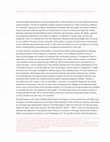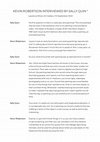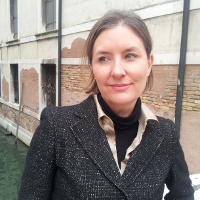Books and Exhibition Catalogues by Sally Quin

Robertson's mother was a florist and the washhouse was always full of wet newspapers and flowers.... more Robertson's mother was a florist and the washhouse was always full of wet newspapers and flowers. His father would draw in the evenings after work, on a lined pad with a biro. From about the age of five, Robertson began to draw too-the land, the sky, houses, people and animals, things real and things imagined. The world around him seemed worthy of patient observation, in all its detail and all its incomprehensible vastness. At Norseman Junior School, Robertson's teacher was impressed by the then eleven year old's gift for drawing, and encouraged his parents to consider sending their son to the Special Art Program at Applecross Senior High School in Perth. By good fortune, Robertson's aunt and uncle lived ten kilometres from the city of Perth, in the suburb of Booragoon, around a kilometre from the school. And so a few years later, aged thirteen, Robertson left Norseman to live in this new suburban household. A life in art had begun. Though Robertson was keen to learn the craft of drawing and painting, even as a young artist it was clear to him that such technical aspects were only part of a more complex exploration of what pigment on canvas could be. Forms and colours arranged in certain ways might depict a specific object or event, but the medium was also capable of moving beyond mere description, creating new realities and capturing powerful feelings. Working in an imaginative representational style has remained central to Robertson's creative relationship to the world. Reflecting on his lifetime of painting in 2022, Robertson stated: 'I am lucky that through painting I found a meaningful way to process my experience, to think about the culture I am immersed in and to dream about the future'. 2 Fig. 1. Kevin Robertson painting in Dunsborough, Western Australia, 1986 Photography by Megan Salmon
Book chapters, articles, reviews, short entries by Sally Quin
Know My Name: Australian Women Artists 1900 to Now, National Gallery of Australia, Canberra, 2020
‘Guy Grey-Smith: Modern Visions of the West’, Art Monthly, July 2014, 36–41
‘”We must risk unlearning”: 1970–present’, Into the Light: The Cruthers Collection of Women’s Art, Crawley: UWA Publishing, 2012, 27–33

Bolognese sculptor Properzia de’ Rossi (c. 1490–1530) is distinguished as the only female artist ... more Bolognese sculptor Properzia de’ Rossi (c. 1490–1530) is distinguished as the only female artist to be afforded extended analysis in Giorgio Vasari's first edition of the Lives of the Painters, Sculptors and Architects (1550). Scholars have focused largely on the way in which Properzia's description aligns with derogatory assumptions about female nature in early modern Italy. While this is a defining characteristic of Properzia's vita, my paper explores alternative and potentially positive aspects of the text, by considering Vasari's attempts to integrate Properzia into the broader enterprise of the Lives and, more generally, art historical discourse of the time. I will argue that Vasari's approach invites a polemical response connected to these wider issues by setting up a paradoxical relationship between Properzia's archetypal female body and the manual movement required of it to sculpt. In contrasting notions of the feminine and the masculine, the noble body and the ignoble body, the intellectual and the manual, Properzia's vita can be connected specifically to the paragone (comparison) between painting and sculpture and also to questions relating to the status of the artist. In such a way the female artist is seen to take on an emblematic and instructive role within the text.
Unlacing Carnal Margins: Portraits by Angela Stewart, Artlink, 2010

in Kevin Robertson, Configured: Aspects of contemporary Western Australian figurative art, 2005
During the Italian Renaissance a profound appreciation of the innovations of Ancient Greek and Ro... more During the Italian Renaissance a profound appreciation of the innovations of Ancient Greek and Roman culture emerged. This did not engender a slavish copying of antiquity but, rather, produced conditions for a renewal of learning and creativity. Renaissance humanists were thoroughly committed to utilising classical precepts within the specific and transformative context of contemporary Italian life. Charles Dempsey notes that the great fifteenth century Florentine ruler and poet, Lorenzo de' Medici, captured this progressive relationship to the past in a preface to a collection of Tuscan verse, the Raccolta Aragonese. Here, it is indicated that 'the new flowering of literature [Lorenzo] envisaged was conceived not as a rebirth of the past, but as a renovatio of the present, in exactly the same sense of the renewal of the world each spring (renovatio mundi). In such a way the present found its own place in an evolving history, renewing itself by assimilating and emulating the achievements of the past … .' 1
Artist Interviews by Sally Quin
I'll start with a question that relates to the room that we are sitting in [the Westpac Gallery].... more I'll start with a question that relates to the room that we are sitting in [the Westpac Gallery]. Shown here are a number of works by artists who participated in the landmark The Field exhibition of 1968, including you Trevor. 1 So around the room we have Dick Watkins, Col Jordan, Sydney Ball,

My first question to Kevin is, basically, why painting? The only example that we have in the exhi... more My first question to Kevin is, basically, why painting? The only example that we have in the exhibition that is not painting is the wonderful video, The Death of Actaeon, a Super-8 film that Kevin made in 1987 [with music by Kim Salmon]. But even that is like a painting, an animated painting. Kevin Robertson: I guess it was an early fascination, just seeing paintings reproduced, and I'm talking about kitsch reproductions because growing up in Norseman there wasn't much fine art to speak of. Also, it was paint, as substance, that from a very young age fascinated me. Sally Quin: So your initial encounter with painting was as reproductions in books? Kevin Robertson: Yes, I think we might have had two art books in the house; one was a fine art book and that was a bit unusual, and the other I prefer not to mention! Then later on when I went to Applecross [Senior] High School, the painting teachers who would come through were just fascinating people, and I learnt a lot from watching them work. I experimented with lots of mediums, you know: tape, videotape, photography and so on, but I found that painting was more flexible for me, for the things that I wanted to do. And it's not time-based, so that's another thing. Whenever I started messing around with audio or video I realized that days had gone by and I hadn't gotten too far. I like the way, in painting, you can achieve a lot in a shorter period of time. Sally Quin: Your work, it's realist art, but with poetic and imaginative elements. It is conceptually very rich. So in painting you found a medium that was fulfilling in terms of the ideas it could convey, as well as technically interesting. Kevin Robertson: Exactly, it's got both those things in it, so you can have a dream, or see something, and then you can translate it into this medium.
Small Exhibition Catalogues by Sally Quin
Approaches to Modernism: The Art of Portia Bennett, Elise Blumann and Iris Francis, 1930s to 1950s, 2004
Transient States: Western Australian Photography








Uploads
Books and Exhibition Catalogues by Sally Quin
Book chapters, articles, reviews, short entries by Sally Quin
Artist Interviews by Sally Quin
Small Exhibition Catalogues by Sally Quin